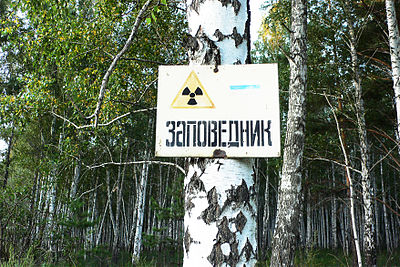free
Country:
Region:
Other names:
Value:
Visit duration:
Price (adult):
free
Description:
It was created to protect the population from radiation and to study the effects of radiation on living organisms and the environment in natural conditions. It is located in the forest-steppe zone on the territory of the Kasli and Kunashak districts of the Chelyabinsk region, its area is 16,616 hectares.
There are only two such reserves in the world — the East Ural Reserve in our country and the Polessky Reserve in Belarus. In both cases, they arose as a result of the largest radiation disasters — the Chernobyl accident on April 26, 1986 and the explosion at the Mayak plant on September 29, 1957.
In 1957, the largest radiation accident in the Urals occurred at the Mayak plant, comparable in scale to Chernobyl (20 million Curies were released here, and 50 million Curies were released in Chernobyl). As a result of the explosion of a 300 cubic meter tank, a huge release of radiation occurred. A vast Eastern Ural Radioactive Trace (EURT) was formed, approximately 300 kilometers long and about 10 kilometers wide. It contaminated not only the territory of the Chelyabinsk region with radiation, but also affected the Sverdlovsk and Tyumen regions. At the same time, the culprit of the accident — the current city of Ozersk — was not affected.
The radioactive accident was strictly classified for many decades. In the West, many more people knew about it than in the USSR. Only in 1989, the authorities released information about the catastrophe that occurred in 1957.
Thousands of people suffered from radiation. 23 settlements disappeared forever from the map of the Urals. Only one or two weeks after the accident, unsuspecting people from the most contaminated villages began to be resettled to other places. Domestic animals were destroyed and buried, buildings were destroyed.
Tens of thousands of liquidators of the “Kyshtym accident” suffered from radiation.
It was created to prevent the removal of radioactive substances from the contaminated territory, to prevent the penetration of the population here, and also to study the effects of radionuclides in natural conditions. Until now, due to high radiation, scientists classify 85% of the reserve’s territory as an ecological disaster zone. Ecologists and biologists carefully study the effects of radiation on living organisms and the environment in natural conditions. As it turned out, representatives of wildlife gradually adapted to high radiation.
The Techa and Karabolka rivers flow through the reserve, there are two lakes: Berdenish and Uruskul. Also adjacent to the reserve territory are lakes Alabuga, Kozhakul, Maloe Travyanoe, Malye and Bolshiye Kirpichiki. Many waterfowl are found on the lakes. At the same time, a lot of radioactive sludge has accumulated at the bottom of the lakes.
This territory is characterized by forest-steppe vegetation: birch forests alternate with steppes. Sometimes there are pine trees. Natural vegetation has been restored on the formerly plowed fields. The trees that died after the accident have already been restored. There are 455 species of higher plants in the reserve, including some species listed in the Red Book. It is curious that rare plants have become 5–10 times more common than before the zone was closed to visitors.
The protected nature of the territory, despite the high level of radiation, has had a beneficial effect on the animal world. They do not even know that there is a lot of radiation here. The vertebrate fauna is represented by 283 species, including 47 species of mammals, 213 species of birds, 15 species of fish, 4 species of reptiles, 4 species of amphibians. There is a high concentration of rare animal species in the protected area.
There is a large population of grey geese, and mute swans, common cranes, grey herons, ducks, and seagulls also nest here. There are 24 species of sandpipers. Here you can also meet the golden eagle, white-tailed eagle, saker falcon, peregrine falcon, osprey, black-headed gull, and Dalmatian pelican, all listed in the Red Book. You can also see such a beautiful bird as the eagle owl. The black-throated loon nests on Lake M. Kirpichiki and reservoir No. 11. The red-necked grebe is occasionally encountered. Sometimes even Dalmatian pelicans are seen here, but there is no information about their nesting.
Mammals are quite common for these areas (but there are significantly more of them than in unprotected areas). Of the larger animals, you can meet elk, lynx, fox, roe deer, wild boar, hare, etc.
Until 1991, the reserve was under the jurisdiction of the Experimental Research Station (ONIS) of the Mayak Production Association. After its liquidation, the reserve actually began to exist only formally. Due to previous secrecy requirements, the reserve was not included in the State Cadastre of Protected Natural Areas. However, it is not possible to enter the territory of the radioactive reserve. It is actively patrolled by the nuclear security. All violators are detained and fined.
Создан для защиты населения от радиации и изучения влияния радиации на живые организмы и окружающую среду в естественных условиях. Расположен в лесостепной зоне на территории Каслинского и Кунашакского районов Челябинской области, его площадь составляет 16 616 га.
Таких заповедников в мире лишь два – Восточно-Уральский у нас и Полесский в Белоруссии. В обоих случаях они возникли в результате крупнейших радиационных катастроф – Чернобыльской аварии 26 апреля 1986 года и взрыва на комбинате «Маяк» 29 сентября 1957 года.
В 1957 году произошла крупнейшая на Урале радиационная авария на комбинате “Маяк”, сопоставимая по масштабам с Чернобыльской (здесь выбросилось 20 млн Кюри, а в Чернобыле – 50). В результате взрыва емкости объемом 300 кубических метров произошел огромный выброс радиации. Образовался обширный Восточно-Уральский радиоактивный след (ВУРС) примерно 300 километров в длину и около 10 километров в ширину. Он заразил радиацией не только территорию Челябинской области, но также задел Свердловскую и Тюменскую области. При этом сам виновник аварии – нынешний город Озерск – не пострадал.
Радиоактивная авария многие десятилетия была строго-настрого засекречена. На Западе о ней знали куда большее количество людей, чем в СССР. Лишь в 1989 году власти обнародовали сведения о произошедшей в 1957 году катастрофе.
Тысячи людей пострадали от радиации. 23 населенных пункта навсегда исчезли с карты Урала. Лишь спустя одну-две недели после аварии ничего не подозревавших людей из наиболее зараженных деревень начали переселять в другие места. Домашних животных при этом уничтожали и закапывали, постройки разрушали.
Десятки тысяч ликвидаторов «Кыштымской аварии» пострадали от излучения.
Создавался для предотвращения выноса с загрязненной территории радиоактивных веществ, недопущения проникновения сюда населения, а также для изучения воздействия радионуклидов в естественных природных условиях. До сих пор вследствие высокой радиации положение на 85% территории заповедника ученые относят к зоне экологического бедствия. Экологи и биологи внимательно изучают влияние радиации на живые организмы и окружающую среду в естественных условиях. Как выяснилось, представители живой природы постепенно адаптировались к высокой радиации.
На территории заповедника текут реки Теча и Караболка, находятся два озера: Бердениш и Урускуль. Также к заповедной территории примыкают озера Алабуга, Кожакуль, Малое Травяное, Малые и Большие Кирпичики. На озерах встречается много водоплавающих птиц. При этом на дне озер скопилось много радиоактивного ила.
Для этой территории характерна лесостепная растительность: березовые леса чередуются со степями. Иногда встречаются сосны. На бывших распаханных полях восстановилась естественная растительность. Погибшие после аварии деревья уже восстановились. В заповеднике встречаются 455 видов высших растений, в том числе некоторые виды, занесенные в Красную книгу. Любопытно, что редкие растения стали встречаться в 5–10 раз чаще, чем до закрытия этой зоны для посещения.
Заповедность территории, несмотря на высокий уровень радиации, благотворно сказалась и на животном мире. Им и не ведомо, что здесь большая радиация. Фауна позвоночных представлена 283 видами, среди которых 47 видов млекопитающих, 213 видов птиц, 15 видов рыб, 4 вида пресмыкающихся, 4 вида земноводных. На заповедной территории большая концентрация редких видов животных.
Здесь большая популяция серого гуся, также гнездятся лебедь-шипун, серый журавль, серая цапля, утки, чайки. Встречается 24 вида кулика. Здесь же можно встретить занесенных в Красную книгу беркута, орлана-белохвоста, сокола балабана, сапсана, скопу, черноголового хохотуна, кудрявого пеликана. Можно увидеть и такую красивую птицу, как филин. На озере М. Кирпичики и водоеме № 11 гнездится чернозобая гагара. Изредка встречается серощекая поганка. Иногда здесь замечают даже кудрявых пеликанов, но сведения о их гнездовании отсутствуют.
Млекопитающие вполне обычны для этих местностей (но их значительно больше, чем на неохраняемых участках). Из наиболее крупных животных можно встретиться с лосем, рысью, лисицей, косулей, кабаном, зайцем и др.
До 1991 года заповедник находился в ведении Опытной научно-исследовательской станции (ОНИС) ПО “Маяк”. После ее ликвидации заповедник фактически стал существовать лишь формально. Из-за прежних требований секретности заповедник не вошел в Государственный кадастр ООПТ. Тем не менее, попасть на территорию радиоактивного заповедника не получится. Его активно патрулирует атомохрана. Всех нарушителей задерживают и штрафуют.
Categories:
Topics:
Why visit:
Interesting:
Fitness level:
Best visit time:
Access:
Roads:
Info:
Clothing:
for the season
Connection:
No
- Why Colombia is dangerous for tourists
- The World’s Most Dangerous Countries for Tourism in 2025
- Global traveler risk ranking 2025
- Island
- Zulfiqar: The Legendary Sword and a Tourist Symbol of the Islamic World
- Greenland
- Majestic Grand Canyon – Unique Nature of the USA
- Holiday in Monaco
- 24 Facts About The Colosseum
- Namaqualand Flower Route
- Somalia: A Country of Risk and Contrasts — Is It Worth Going?
- Evacuation of Kyiv icons takes fight for Ukraine’s heritage to Louvre in Paris
- Domestic animals
- Cod Wars
- Issyk-Kul
- Finland
- How to follow Donald Trump’s travel trail
- Where tourists are kidnapped for ransom
- Indians
- Paradise for Sea Lovers: World Regions with the Most Swimming Beaches











